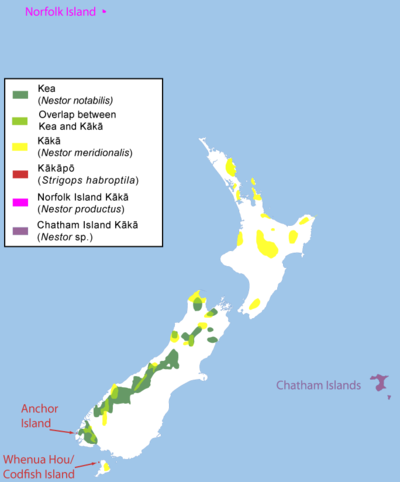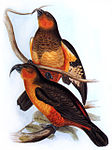ന്യൂസിലാന്റ് തത്ത
| New Zealand parrots Temporal range: Early Miocene to present
| |
|---|---|

| |
| New Zealand kaka, North Island subspecies (Nestor meridionalis septentrionalis) at Auckland Zoo, New Zealand | |
| ശാസ്ത്രീയ വർഗ്ഗീകരണം | |
| കിങ്ഡം: | |
| Phylum: | |
| Class: | |
| Order: | |
| Family: | |
നെസ്റ്റർ, സ്ട്രിഗോപ്സ്, ഫോസിൽ നെലെപ്സിറ്റാകസ് [1][2] എന്നീ മൂന്നു ജീനസ്സുകളുൾപ്പെടുന്ന സൂപ്പർ കുടുംബമായ സ്ട്രിഗോപോയിഡിയിലെ[3] ഒരു സ്പീഷീസാണ് ന്യൂസിലാന്റ് തത്ത. നെസ്റ്റർ ജനുസ്സിൽ കീ, കാക്ക, നോർഫോക് ദ്വീപ് കാക്ക, ചാത്തം ഐലൻഡ് കാക്ക എന്നിവ ഉൾപ്പെടുന്നു.[4][5]
സാധാരണ നാമങ്ങൾ[തിരുത്തുക]

പുരാതനമായ മാവോറി പേരുകൾ പോലെ തന്നെയാണ് ഈ കുടുംബത്തിലെ സ്പീഷീസുകളുടെ പൊതുവായ പേരുകൾ[7]തത്ത എന്നർഥമുള്ള പുരാണ പ്രോട്ടോ-പോളിനേഷ്യൻ വാക്കിൽ നിന്നാണ് മായോരി പദമായ കാകൻ ഉത്ഭവിച്ചത്.[8] കാകപോ എന്നത് ആ പേരിന്റെ യുക്തിയുക്തമായ ഒരു വിപുലീകരണമാണ് അതായത് പോ എന്നാൽ രാത്രി എന്നർത്ഥം, രാത്രി കാക്ക അല്ലെങ്കിൽ രാത്രി തത്ത എന്നർത്ഥം വരുന്ന ഇവ നിശാജീവികളുടെ സ്വഭാവം പ്രകടിപ്പിക്കുന്നു. [9](മാവോറി ഭാഷയുടെ ആധുനിക ഔർത്തോഗ്രാഫിയിൽ, സ്വരാക്ഷരത്തിന്റെ നീണ്ട പതിപ്പുകൾ a ഉം o ഉം മാക്രോണുകളായി എഴുതപ്പെട്ടിരിക്കുന്നു, അതായത്, ā, ō.)[10][11] മാവോറിയിലെ കെഇ എന്ന പദത്തിന്റെ വ്യാഖ്യാനം കുറവാണ്; ഇത് വിളിക്കുന്ന ശബ്ദത്തിൻറെ കീ-ആഹയുടെ ഉറവിടം ആകാം.[12]
സ്പീഷീസ്[തിരുത്തുക]
ചാത്തംകാക്കയെക്കുറിച്ച് വളരെ കുറച്ച് കാര്യങ്ങൾ മാത്രമേ അറിയാൻ കഴിഞ്ഞിട്ടുള്ളൂ. "നെലെപ്സിറ്റാകസ് ജനുസ്സിൽ മൂന്നു വിവരണം ലഭ്യമായ സ്പീഷീസുകളും ആദ്യകാല മയോസെൻ കാലഘട്ടങ്ങളിലെ അവശിഷ്ടങ്ങളിൽ നിന്നും കണ്ടെത്തിയ വിവരണം നൽകാത്ത ഒരു സ്പീഷീസും ഇതിൽ ഉൾക്കൊള്ളുന്നു..[2]
| Common name (binomial name) Status |
Image | Description | Range and habitat |
|---|---|---|---|
| Nestoridae | |||
| Kea (Nestor notabilis) |
 |
48 cm (19 in) long. Mostly olive-green with scarlet underwings and rump. Dark-edged feathers. Dark brown beak, iris, legs, and feet. Male has longer bill.[14] | New Zealand: South Island High-level forests and subalpine scrublands 850–1400 m AMSL.[6] |
| South Island kaka (Nestor meridionalis meridionalis) |
 |
Similar to the North Island kaka, but slightly smaller, brighter colours, the crown is almost white, and the bill is longer and more arched in males.[16] | New Zealand: South Island Unbroken tracts of Nothofagus and Podocarpus forests 450–850 m AMSL in summer and 0–550 m in winter.[6] |
| North Island kaka (Nestor meridionalis septentrionalis) |
 |
About 45 cm (18 in) long. Mainly olive-brown with dark feather edges. Crimson underwings, rump, and collar. The cheeks are golden/brown. The crown is greyish.[16] | New Zealand: North Island Unbroken tracts of Nothofagus and Podocarpus forests between 450–850 m AMSL in summer and 0–550 m in winter.[6] |
| Norfolk kaka |
 |
About 38 cm long. Mostly olive-brown upperparts, (reddish-)orange cheeks and throat, straw-coloured breast, thighs, rump and lower abdomen dark orange[18] | Formerly endemic on Norfolk Island and adjacent Phillip Island[19] Rocks and trees |
| Chatham kaka (Nestor sp.) |
Appearance unknown, but bones indicate reduced flight capability | Only known from subfossil bones. | Formerly endemic on Chatham Island of New Zealand Forests[21] |
| Strigopidae | |||
| Kakapo (Strigops habroptila) |
 |
Large rotund parrots 58–64 cm (23–25 in) long; males are larger than females and weigh 2–4 kg (4.4–8.8 lb) at maturity. Mostly green with brown and yellow mottled barring, the underparts are greenish-yellow. Its face is pale and owl-like.[23] | New Zealand: Maud, Chalky, Codfish and Anchor Islands Climax Nothofagus (beech) and Podocarpus (conifer) forests, regenerating subalpine scrub, snow tussock Danthonia grassland 10–1400 m AMSL.[6] |
ഇതും കാണുക[തിരുത്തുക]
- Kakariki, New Zealand parakeets
- Fauna of New Zealand
അവലംബങ്ങൾ[തിരുത്തുക]
- ↑ Christidis L, Boles WE (2008). Systematics and Taxonomy of Australian Birds. Canberra: CSIRO Publishing. p. 200. ISBN 978-0-643-06511-6.
- ↑ 2.0 2.1 Worthy, Trevor H.; Tennyson, Alan J. D.; Scofield, R. Paul (2011). "An early Miocene diversity of parrots (Aves, Strigopidae, Nestorinae) from New Zealand". Journal of Vertebrate Paleontology. 31 (5): 1102–16. doi:10.1080/02724634.2011.595857.
- ↑ Nestoridae and Strigopidae are described in the same article, Bonaparte, C.L. (1849) Conspectus Systematis Ornithologiae. Therefore, under rules of the ICZN, the first reviser determines priority, which is Bonaparte, C.L. (1850), Conspectus Generum Avium, E.J. Brill, Leyden.
- ↑ Forshaw, Joseph M.; Cooper, William T. (1981) [1973, 1978]. Parrots of the World (corrected second ed.). David & Charles, Newton Abbot, London. ISBN 0-7153-7698-5.
- ↑ Millener, P. R. (1999). "The history of the Chatham Islands' bird fauna of the last 7000 years – a chronicle of change and extinction. Proceedings of the 4th International meeting of the Society of Avian Paleontology and Evolution (Washington, D.C., June 1996)". Smithsonian Contributions to Paleobiology. 89: 85–109.
- ↑ 6.0 6.1 6.2 6.3 6.4 Juniper, Tony; Mike Parr (1998). Parrots: A Guide to Parrots of the World. Yale University Press. ISBN 978-0300074536.
- ↑ "Maori Bird Names". Kiwi Conservation Club. Archived from the original on 22 May 2010. Retrieved 12 December 2012.
- ↑ "Kaakaa". Polynesian Lexicon Online. Retrieved 2012-02-29.
- ↑ "kakapo". The American Heritage Dictionary of the English Language: Fourth Edition. 2000. Archived from the original on 2008-04-20. Retrieved 2008-12-31.
- ↑ "The Māori Language – Ko Te Reo". Retrieved 2009-01-01.
- ↑ "Māori dictionary". Archived from the original on 2012-02-19. Retrieved 2009-01-02.
- ↑ "kea". The American Heritage Dictionary of the English Language: Fourth Edition. 2000. Archived from the original on 2008-04-18. Retrieved 2008-12-31.
- ↑ BirdLife International (2008). "Nestor notabilis". IUCN Red List of Threatened Species. Version 2008. International Union for Conservation of Nature. Retrieved 24 December 2008. Database entry includes a range map and justification for why this species is endangered.
- ↑ "Kea – BirdLife Species Factsheet". BirdLife International. 2008. Archived from the original on 2013-05-19. Retrieved 2018-09-22.
- ↑ BirdLife International (2008). "Nestor meridionalis". IUCN Red List of Threatened Species. Version 2008. International Union for Conservation of Nature. Retrieved 24 December 2008. Database entry includes a range map and justification for why this species is endangered.
- ↑ 16.0 16.1 "Kaka – BirdLife Species Factsheet". BirdLife International. 2008. Archived from the original on 2013-05-19. Retrieved 2018-09-22.
- ↑ BirdLife International (2008). "Nestor productus". IUCN Red List of Threatened Species. Version 2008. International Union for Conservation of Nature. Retrieved 24 December 2008.
- ↑ Forshaw, Joseph M.; Cooper, William T. (1981) [1973, 1978]. Parrots of the World (corrected second ed.). David & Charles, Newton Abbot, London. ISBN 0-7153-7698-5.
- ↑ "Norfolk Island Kaka – BirdLife Species Factsheet". BirdLife International. 2008. Archived from the original on 2013-05-19. Retrieved 2018-09-22.
- ↑ Millener, P. R. (1999). "The history of the Chatham Islands' bird fauna of the last 7000 years – a chronicle of change and extinction. Proceedings of the 4th International meeting of the Society of Avian Paleontology and Evolution (Washington, D.C., June 1996)." Smithsonian Contributions to Paleobiology. 89: 85–109.
- ↑ Millener, P. R. (1999). "The history of the Chatham Islands' bird fauna of the last 7000 years – a chronicle of change and extinction. Proceedings of the 4th International meeting of the Society of Avian Paleontology and Evolution (Washington, D.C., June 1996)." Smithsonian Contributions to Paleobiology. 89: 85–109.
- ↑ BirdLife International (2008). "Strigops habroptila". IUCN Red List of Threatened Species. Version 2008. International Union for Conservation of Nature. Retrieved 24 December 2008. Database entry includes a range map and justification for why this species is endangered,
- ↑ "Kakapo – BirdLife Species Factsheet". BirdLife International. 2008. Archived from the original on 2009-01-02. Retrieved 2018-09-22.
